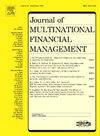绿色债券:企业绿色投资效率的催化剂还是制约因素?
IF 4
3区 经济学
Q2 BUSINESS, FINANCE
Journal of Multinational Financial Management
Pub Date : 2025-07-15
DOI:10.1016/j.mulfin.2025.100920
引用次数: 0
摘要
绿色债券已成为企业绿色投资的重要外部融资渠道。然而,只关注投资规模而不考虑效率,是对这类债券作用的不完整理解。本文利用DEA-Malmquist模型研究了绿色债券对绿色投资效率(GIE)的影响,并考虑了不良产出。并探讨了这种关系的影响因素和机制。研究发现:(1)绿色债券主要通过提高技术效率而非技术进步来提升全球GIE。绿色债券规模与GIE呈倒u型关系。(2)在代理成本较低的企业、政府补贴有限的企业、国有企业和重污染行业的企业中,这种效应更为明显。(3)绿色债券通过缩小内部绿色治理的差距和放大外部压力(如媒体关注)来促进绿色能源生产。(4)随着时间的推移,绿色技术创新的减排效益和效率表现出滞后效应。这些发现为绿色债券的作用提供了宝贵的见解,为其经济和环境影响提供了双重视角,同时为企业可持续发展的政策和实践提供了指导。本文章由计算机程序翻译,如有差异,请以英文原文为准。
Green bonds: Catalyst or constraint for corporate green investment efficiency?
Green bonds have emerged as a critical external financing channel for corporate green investments. However, focusing solely on the scale of investment without considering efficiency provides an incomplete understanding of the role of such bonds. This paper investigates the impact of green bonds on green investment efficiency (GIE) using the DEA-Malmquist model, incorporating undesirable outputs. It also explores the influencing factors and mechanisms underlying this relationship. The key findings include the following: (1) Green bonds enhance GIE primarily through improved technical efficiency rather than technological progress. The scale of green bonds has an inverted U-shape relationship with GIE. (2) The effect is more pronounced in firms with low agency costs, firms with limited government subsidies, state-owned enterprises, and firms in heavily polluting industries. (3) Green bonds contribute to GIE by bridging the gaps in internal green governance and amplifying external pressures, such as media attention. (4) A lag effect is observed, with benefits for pollution reduction and the efficiency of green technological innovation manifesting over time. These findings provide valuable insights into the role of green bonds, offering a dual perspective on their economic and environmental impacts while guiding policies and practices for sustainable corporate development.
求助全文
通过发布文献求助,成功后即可免费获取论文全文。
去求助
来源期刊

Journal of Multinational Financial Management
BUSINESS, FINANCE-
CiteScore
7.30
自引率
4.80%
发文量
25
审稿时长
30 days
期刊介绍:
International trade, financing and investments have grown at an extremely rapid pace in recent years, and the operations of corporations have become increasingly multinationalized. Corporate executives buying and selling goods and services, and making financing and investment decisions across national boundaries, have developed policies and procedures for managing cash flows denominated in foreign currencies. These policies and procedures, and the related managerial actions of executives, change as new relevant information becomes available. The purpose of the Journal of Multinational Financial Management is to publish rigorous, original articles dealing with the management of the multinational enterprise. Theoretical, conceptual, and empirical papers providing meaningful insights into the subject areas will be considered. The following topic areas, although not exhaustive, are representative of the coverage in this Journal. • Foreign exchange risk management • International capital budgeting • Forecasting exchange rates • Foreign direct investment • Hedging strategies • Cost of capital • Managing transaction exposure • Political risk assessment • International working capital management • International financial planning • International tax management • International diversification • Transfer pricing strategies • International liability management • International mergers.
 求助内容:
求助内容: 应助结果提醒方式:
应助结果提醒方式:


